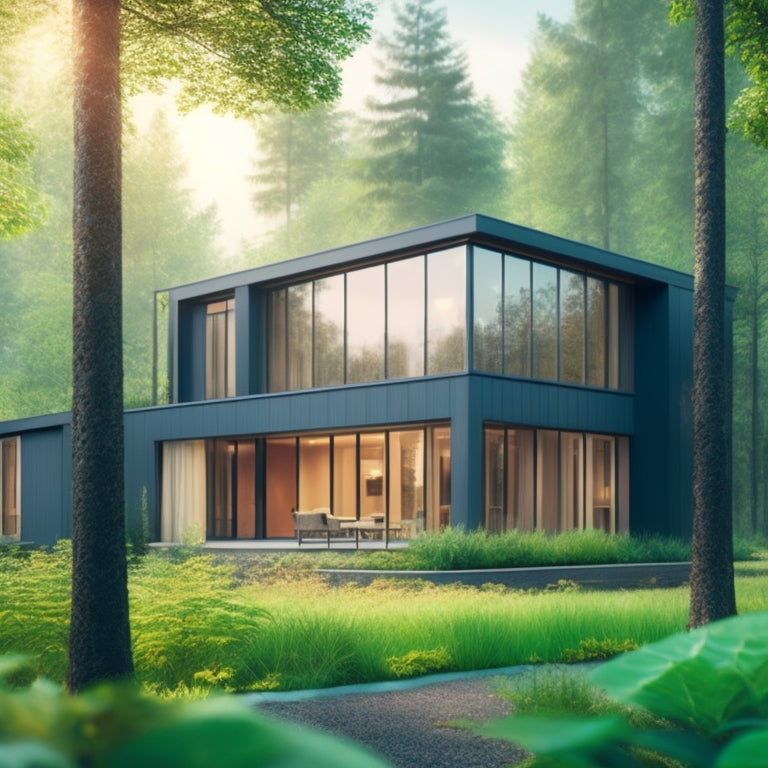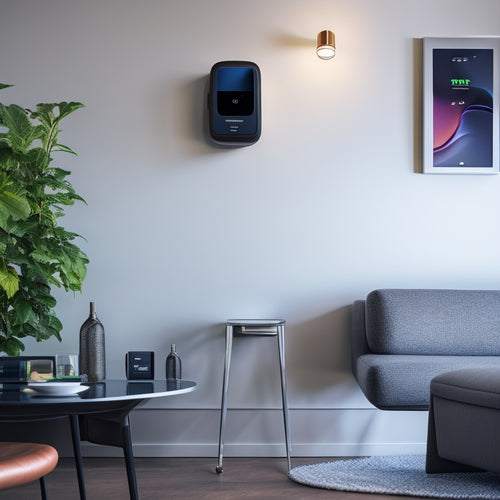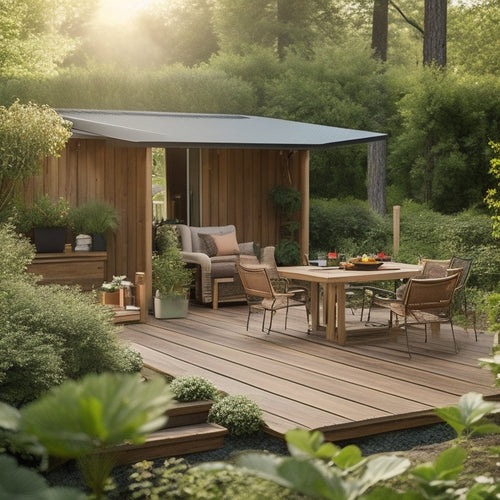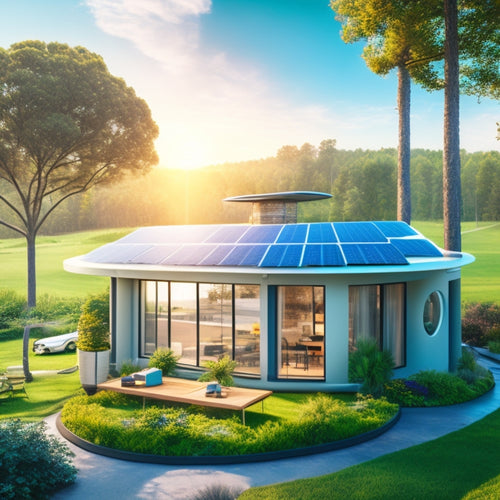
Why Passive Houses Need Better Ventilation Solutions
Share
You're living in a passive house, surrounded by an airtight building envelope that dramatically reduces heat loss, but this same feature also limits airflow, leading to a vital need for innovative ventilation solutions. You need to balance minimal air leakage with controlled ventilation to maintain ideal indoor air quality, which is essential for your health and comfort. Without proper ventilation, you risk mold growth, airborne pollutants, and reduced thermal comfort. It's imperative to understand the challenges of ventilation in passive houses and investigate efficient solutions that minimize energy losses while ensuring a fresh air supply, and there's more to uncover about achieving this delicate balance.
Key Takeaways
- Passive houses require better ventilation solutions to balance minimal air leakage with controlled ventilation, ensuring consistent air exchange rates and indoor air quality.
- Inadequate air exchange in passive houses can lead to health impacts from airborne pollutants, chemical off-gassing, and outdoor allergens.
- Heat recovery ventilation systems are essential in passive houses to minimize energy losses while ensuring a fresh air supply and maintaining indoor air quality.
- Balanced air flow is critical in passive houses to maintain pressure balance, optimize system performance, and prevent moisture issues and inefficient heat exchange.
- Innovative ventilation solutions are necessary to reduce the carbon footprint of passive houses while enhancing thermal comfort, energy efficiency, and indoor air quality.
Ventilation Challenges in Passive Houses
Since the inception of passive house design, ventilation has posed a significant challenge. You're tasked with creating an airtight building envelope, which reduces heat loss, but also limits airflow. This contradiction makes it difficult to maintain ideal indoor air quality.
You must balance the need for minimal air leakage with the requirement for controlled ventilation. As we shift towards a more sustainable future, similar to how electric vehicles reduce greenhouse gas emissions, passive houses also require innovative solutions to reduce their carbon footprint.
Airflow mechanics play a critical role in passive house ventilation, as you need to guarantee consistent air exchange rates without compromising the building's energy efficiency.
Humidity control is another essential aspect, as excess moisture can lead to mold growth and indoor air quality issues. By understanding these challenges, you can design effective ventilation solutions that meet the unique demands of passive houses.
Indoor Air Quality Concerns
In conjunction with the airtight building envelope, a passive house's ventilation system must also mitigate indoor air quality concerns that can arise from inadequate air exchange.
You need to evaluate the potential health impacts of airborne pollutants, chemical off-gassing from building materials, and outdoor allergens that can infiltrate your home.
Moreover, incorporating renewable energy sources, such as solar energy, can reduce reliance on non-renewable energy and promote a sustainable future.
Implementing effective humidity control measures, like those found in commercial EV charging stations, can also prevent moisture buildup.
To guarantee occupant comfort and maintain good indoor air quality, you should:
- Implement effective humidity control measures to prevent moisture buildup
- Verify ventilation rates are adjusted according to seasonal variations
- Select building materials that minimize chemical emissions and promote energy efficiency
Heat Recovery Ventilation Systems
You're likely familiar with the importance of efficient heat exchange, balanced air flow, and a consistent fresh air supply in a passive house.
Heat recovery ventilation systems are designed to address these concerns, and you'll want to contemplate how they can be integrated into your design. By leveraging heat recovery technology, you can minimize energy losses while maintaining a healthy indoor environment.
Additionally, incorporating renewable energy sources, such as solar-powered fast charging, can further reduce the carbon footprint of your passive house.
Efficient Heat Exchange
As you investigate the intricacies of passive house design, efficient heat exchange emerges as an essential component of a successful ventilation strategy.
It's important to minimize heat loss while maintaining ideal indoor air quality. Heat recovery ventilation systems play a vital role in achieving this balance.
Incorporating solar panels to power these systems can greatly reduce energy costs and carbon footprint, relying on renewable energy. By doing so, you can guarantee a sustainable and eco-friendly ventilation solution.
By incorporating a heat exchanger, you can recover up to 90% of the heat energy from exhaust air and transfer it to fresh air.
This process enhances:
- Thermal comfort by providing a consistent indoor temperature
- Energy efficiency by reducing the need for heating and cooling
- Indoor air quality by removing stale air and introducing fresh air
Balanced Air Flow
Ideal airflow is the linchpin of a well-functioning heat recovery ventilation system, and achieving balanced air flow is essential to reap its benefits.
You need to verify that the air distribution system supplies and extracts the same volume of air to maintain pressure balance. This balance is critical, as any imbalance can lead to inefficient heat exchange, reduced indoor air quality, and even moisture issues.
Additionally, incorporating energy-efficient solutions, such as solar-powered charging, can further optimize the system's performance.
Furthermore, designing the system with energy storage systems in mind can enhance grid resiliency and reduce reliance on traditional power sources.
To achieve balanced air flow, you should design the system to compensate for pressure differences between the supply and extract air streams. This can be accomplished through careful system design, component selection, and commissioning.
Fresh Air Supply
Maintaining a balanced air flow is just the first step in enhancing your heat recovery ventilation system. To guarantee a fresh air supply, you need to evaluate several factors that impact air quality, occupant comfort, and energy efficiency. A well-designed heat recovery ventilation system should provide a consistent supply of fresh air while minimizing energy losses.
-
System integration with humidity control and noise reduction features is important to maintain a comfortable indoor environment.
-
Design flexibility is necessary to accommodate various building layouts and occupant needs.
-
User education is essential to guarantee that you understand how to operate and maintain your system for peak performance.
Natural Ventilation Design Strategies
When designing natural ventilation systems for passive houses, you'll need to carefully consider window placement to maximize airflow and minimize heat loss.
You'll also want to utilize the stack ventilation effect, which occurs when warm air rises and exits through upper-level vents, to create a continuous flow of fresh air.
Window Placement Matters
During the design phase of a passive house, careful consideration should be given to window placement, as it plays a critical role in natural ventilation strategies.
You'll want to optimize window orientation to capture natural breezes and reduce the need for mechanical ventilation.
When placing windows, consider the following:
-
Window orientation: South-facing windows can maximize heat gain during winter, while north-facing windows can reduce heat gain during summer.
-
External shading: Overhangs, louvers, or solar shades can block direct sunlight during summer, reducing cooling loads.
-
Cross-ventilation: Strategically placing windows on opposite sides of the building can facilitate airflow and enhance natural ventilation.
Stack Ventilation Effectiveness
As you optimize window placement for natural ventilation, you'll also want to contemplate stack ventilation as a complementary strategy.
This approach utilizes the natural stack pressure created by thermal stratification, where warm air rises and cooler air sinks. By incorporating vertical ventilation shafts or chimneys, you can exploit this pressure to facilitate airflow.
As warm air exits through the top of the shaft, cooler air is drawn in through the bottom, creating a continuous circulation of air. This natural convection process can be particularly effective in Passive Houses, where airtight construction and insulation minimize heat loss.
Cross Ventilation Techniques
Two primary cross ventilation techniques are employed in natural ventilation design strategies: single-sided and cross ventilation.
You'll find that single-sided ventilation occurs when windows on one side of a room are opened to allow air to enter and exit, while cross ventilation involves opening windows on opposite sides to create a flow of air through the room.
This latter technique offers several benefits, including:
- Enhanced airflow rates, reducing the risk of stagnation
- Improved indoor air quality through increased ventilation
- Reduced reliance on mechanical ventilation systems, promoting energy efficiency and design flexibility
Filter Efficiency and Maintenance
Airborne contaminants in a passive house can greatly impact indoor air quality, making filter efficiency and maintenance vital components of a well-functioning ventilation system.
You need to verify that your filters are capable of capturing particles as small as 0.3 microns to effectively remove pollutants. Regular maintenance is important to prolong filter lifespan, which can range from 1-3 years depending on usage and environmental conditions.
You should check and replace filters at a frequency of every 1-3 months, or as recommended by the manufacturer. Failure to do so can lead to reduced airflow, increased energy consumption, and compromised indoor air quality.
Whole-House Ventilation Solutions
In a passive house, a well-designed whole-house ventilation system is essential to maintaining ideal indoor air quality and energy efficiency.
You need a system that can provide a consistent supply of fresh air while minimizing heat loss.
A good whole-house ventilation system should include features such as:
-
Energy recovery: a heat exchanger that transfers heat from exhaust air to fresh air, reducing the energy needed for heating and cooling
-
Humidity control: a system that regulates moisture levels to prevent mold growth and maintain a comfortable indoor environment
-
Automated control: a system that automatically adjusts ventilation rates based on factors like CO2 levels, humidity, and temperature
Frequently Asked Questions
Can Passive Houses Be Built in Hot and Humid Climates?
You can build passive houses in hot and humid climates, but you'll need to take into account climate-specific design adaptations, such as optimized shading, increased insulation, and smart ventilation strategies to maintain a comfortable indoor environment.
Do Passive Houses Require More Complex Ventilation Systems?
You'll find that passive houses indeed require more complex ventilation systems, as they need a precise ventilation design to maintain ideal air quality, ensuring a healthy indoor environment while minimizing energy losses and maximizing freedom from respiratory issues.
Are Heat Recovery Ventilation Systems Worth the Extra Cost?
You might think heat recovery ventilation systems are too pricey, but they're worth the extra cost, as they provide significant cost benefits and energy efficiency, allowing you to breathe easy while keeping your energy bills in check.
Can Natural Ventilation Strategies Replace Mechanical Systems Entirely?
You can utilize natural ventilation strategies, but they require careful design considerations to maximize natural airflow benefits, ensuring consistent indoor air quality and temperature control, making them a viable alternative to mechanical systems in certain climates and building types.
How Often Should Ventilation Filters Be Replaced in Passive Houses?
You'll want to breathe easy, literally, by replacing ventilation filters every 3-6 months, depending on usage and air quality, to guarantee ideal filter maintenance and protect indoor air quality in your passive haven.
Related Posts
-

7 Best EV Battery Health Trackers for Homeowners
You can maximize your electric vehicle's performance and lifespan by leveraging advanced battery health trackers that...
-

Green Deck Options: Earth-Conscious Choices for Your Home
You're looking for a deck that not only enhances your home's exterior but also aligns with your eco-friendly values. ...
-

Gamify Your Home's Energy Generation and Savings
You're taking the next step in optimizing your home's energy generation and savings by utilizing the power of gamific...


